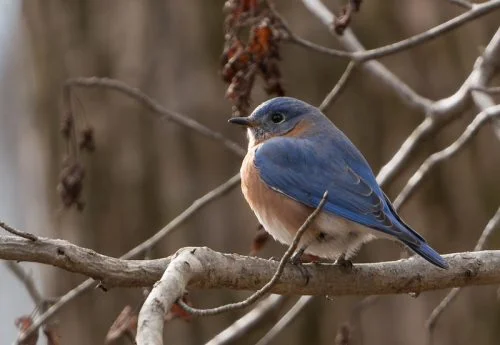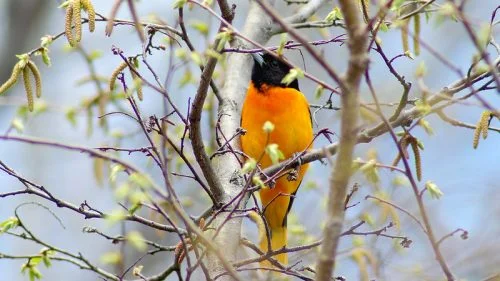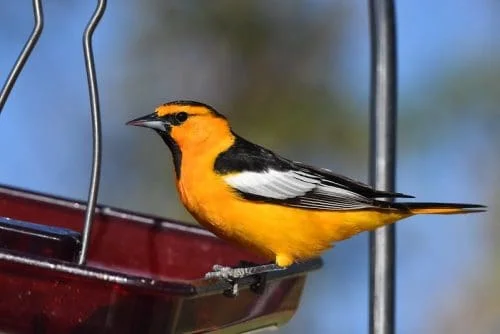North America is filled with many wonderful birds with orange bellies – in fact, there are 15 birds that you can spot. Have you spotted a bird with an orange belly that you’re looking to identify? Look no further than this article.
This list will list all 15 birds and help birdwatchers find and identify all birds of North America that have orange bellies with both pictures and calls.
1. Rufous Hummingbird

Rufous Hummingbirds are remarkable creatures with brilliant flame-like orange bellies.
They are lively and ruthless, known for their defensive and relentless attacks against other (sometimes larger) hummingbirds in a quest for food. These birds are perhaps one of the most active and hostile hummingbirds found in North America.
They are widespread across several states and will travel almost 4,000 miles between Mexico and Alaska – further North than any other hummingbird despite being tiny creatures. As well as a vibrant orange belly, these birds have a namesake rufous coating on their backs that occasionally displays some green spotting. Females are more likely to have some greener feathers.
In breeding seasons, these birds are likely to reside in Western states such as California and further Northwest through Canada into Alaska. In fall they prefer to find habitats amongst the Rocky Mountains before heading southwards for the winter.
They are occasional visitors of backyards and even backyard hummingbird feeders – which is one of the places they prepare to fight and prevent other hummingbirds from feeding there. Although they do spend much of the year travelling, they can be found in parks and fields too, often near flowers.
They have a distinct wing buzz when they fly which is a great pointer to help spot the species.
To learn more about the Rufous Hummingbird you can visit: https://www.audubon.org/field-guide/bird/rufous-hummingbird
2. Eastern Bluebird

Throughout much of the year, Eastern Bluebirds can be found in small flocks in the Eastern parts of North America.
They are in fact the state bird of New York and Missouri, where they are most frequently found. Much like other Bluebirds, they have wonderful royal blue heads, backs and wings. They also have rusted orange and white feathers across their bellies that makes for a striking contrast of colours.
These birds are small and plump and have particularly long wings – a primal distinction from the Western Bluebird. Females are likely paler and greyer and have far whiter bellies than orange.
Often in flocks, these birds will likely reside in fields and open woodlands, nesting and hiding among cavities and occasionally perching on poles and telephone wires.
They also have a distinctly soft call, which may help in identifying them. Alongside treelines they can be found foraging for food, namely small insects like caterpillars and grasshoppers.
In non-breeding seasons they may also forage near meadows and bushes for fruit and berries. Winter months see these birds venture further afield towards Texas and Colorado on occasion, as well as towards the eastern parts of Central American countries like Nicaragua.
To learn more about the Eastern Bluebird you can visit: https://www.audubon.org/field-guide/bird/eastern-bluebird
3. American Robin

American Robins, renowned for their petite and picturesque bodies, are remarkable creatures. Although their plumages are likely perceived to be red, they are in fact more of a rich orange colour, providing these birds with their place in this list.
The rest of their bodies is a dark brown shade, with small white patches on their tails. They have long legs and are notorious for hopping along gardens and lawns.
Spotting these birds is very common, they are widespread across most of North America.
They are also regular visitors of backyards and gardens, making them very popular. Often, they are seen foraging for earthworms out of the ground and can also be rather easily attracted to backyard feeders.
Robins are celebrated singers; whose songs are cheery and easily identifiable. Commonly, in Winter, these birds congregate with others alike to form small flocks that gather in fruiting trees and forage together for berries.
To learn more about American Robin you can visit: https://www.audubon.org/field-guide/bird/american-robin
4. Barn Swallow

Perhaps the most active and acrobatic bird in this list is the Barn Swallow. These birds are small and mighty, as well as truly beautiful. They have a luscious dark blue wash on their faces and upper bodies, as well as a contrasting rouged-orange pigment on their chins that extends downwards onto their bellies.
As well as a remarkable colour display, these birds are rather uniquely shaped; with flattened heads, broad shoulders and iconic long, deep forked tails.
Barn Swallows are popular with bird watchers as they are not only attractive creatures, but also very active and exciting birds.
They breed across most of North America, usually in highly open and populated areas like parks, fields and roadsides.
Occasionally they can be found near water, particularly ponds and coastal waters. These birds are also renowned for their nest building abilities, and these remarkable nests are relatively easy to spot in places such as bridges and sheds. Winter season sees their return into South America.
To learn more about the Barn Swallow you can visit: https://www.audubon.org/field-guide/bird/barn-swallow
5. Baltimore Oriole

There is no denying the magnificence of the Baltimore Oriole. These birds are eye-catching and vibrant, with flame-orange bellies that deeply contrast with their blackened heads and glossy brown bodies.
This brightly pigmented plumage is most commonly attributed to male Orioles; however, females have partial golden-orange feathers too. Female Baltimore Orioles are in fact notorious for their hanging nest-weaving abilities, and males are renowned for boasting their colourful plumages from exposed branches in high trees.
Spotting a Baltimore Oriole is relatively easy. They are in fact the official state bird of Maryland (home to the namesake baseball team). In such Eastern states, particularly in the summer months, these birds are very active and pervasive.
They are mostly seen perched in trees near parks and houses, and can be identified easily by their loud, whistling song which is exclusive to the species. Bird feeders are likely to help attract these Orioles, and they are particularly attracted to oranges.
The winter months sees these birds fly Southwards towards warmer climates, sometimes choosing to reside in Florida, as well as further into Central and South America.
To learn more about the Baltimore Oriole you can visit: https://www.audubon.org/field-guide/bird/baltimore-oriole
6. Bullock’s Oriole

Deserving of a place in this list is the Bullock’s Oriole, another fiery-orange bellied Oriole common to many of North American states.
They can be confused in their appearance with the Baltimore Orioles, but a good distinction is their deep black backs and black line across their eyes, and females are predominantly yellow.
Their faces are the brightest in colour, which is helpful to spot this species among nature, especially as they forage for food.
These birds frequently forage alone, although they do form small flocks outside of the breeding seasons. They likely forage amongst trees and shrubbery – and are mostly attributed to wooded areas.
It is also likely, however, to find these birds near freshwater and farms, and they are occasional residents of towns and parks. The Western states are primarily where these birds breed and, in winter, they are likely to migrate into Mexico.
To learn more about the Bullock’s Oriole you can visit: https://www.audubon.org/field-guide/bird/bullocks-oriole
7. American Woodcock

Perhaps the most curious and unique bird in this list is the American Woodcock. These birds are very large and plump, with very heavy heads that conceals their necks and makes them look predominantly round.
Their feathers are remarkably camouflaged, with pigments of black, brown and grey lacing together and concealing them against the woodlands that they hide within.
Their plump demeanour also conceals their brilliant orange bellies. These birds also have a unique expression on their faces, with heavy black eyes set widely apart, making them appear rather goofy.
Eastern states are most preferred habitats for this species. They are commonly attributed to woodlands and shrubbery, where they hide during most of the day. These birds have particularly long bills to help them probe the earth for earthworms. Along forest edges and fields, you may hear their loud chirps and twittering, particularly in Spring.
To learn more about the American Woodcock you can visit: https://www.audubon.org/field-guide/bird/american-woodcock
8. Say’s Phoebe

They perhaps aren’t the most colourful birds in this list, but Say’s Phoebes are deserving of recognition as they too have attractive orange bellies. They are a somewhat dull grey colour overall and have a brown-orange wash on their lower bodies, particularly on the belly.
Males and females are similar in pigment, and both have stark black tails. Say’s Phoebes are small and slender flycatchers with rather large and distinct looking heads.
They have, quite remarkably, been present in North America for hundreds of years, most commonly in Western states like California and Arizona. This species can also be attributed to Eastern parts of the U.S. year-round, as well as southwards into Mexico during the winter.
During breeding seasons, they are likely found in open and dry habitats such as canyons, deserts and dry foothills. They nest in concealed structures and rock cavities for protection and, contrary to most of the other birds in this list, they tend to stay away from any forests.
To learn more about the Say’s Phoebe you can visit: https://www.audubon.org/field-guide/bird/says-phoebe
9. Allen’s Hummingbird

Another bird with a remarkable orange-red wash is the Allen’s Hummingbird. They are very similar to and often mistaken for the Rufous Hummingbirds, but Allen’s are not as widespread in North America.
These birds are a burnt-copper orange colour with some bronze-green on their backs. They also have some bronze speckles on their throats and an orange belly that is redder than other orange-bellied birds found in North America. Allen’s are petite and stocky, with long bills and tails.
They are almost exclusively found on the West coast, spending much of the year in and around California and Oregon. In winter, some may travel south into Mexico too, albeit only for a very short period before returning to the North American coast.
Their preferred habitats are mainly coastal forests and green areas, where they are active and social and very easy to spot.
To learn more about the Allen’s Hummingbird you can visit: https://www.audubon.org/field-guide/bird/allens-hummingbird
10. Red Knot

Red Knots are colourful sandpipers with a combination of black and reddish-gold feathers on their upperparts, and beautiful orange faces and bellies. They are unique birds, with short and plump bodies as well as sharp wings with some silver tones. In non-breeding seasons, these birds appear far paler and greyer, with much whiter plumages.
They are very much coastal birds, preferring habitats along the waterfront such as beaches and mudflats. Their diet is primarily ocean and other water-based creatures, such as marine worms, shrimp and crab eggs.
Red Knots are often found in flocks with other shorebirds alike, frequently foraging together. They are almost exclusively found on the East coast of the U.S., and do not tend to migrate further inland. Their population in North America has actually declined rapidly over recent decades, as food supplies decline.
11. Varied Thrush

Deserving of a place on this list is the remarkable Varied Thrush. They are rich blue and orange birds, with slate-like bodies and flame orange underparts. Distinctively, these birds have orange eyebrow stripes and dark blue bands on their breasts that look like collars.
Their wings also have speckles of orange on their edges. They are bold birds, with wonderful colour combinations. Another distinguishable feature of this species is their plump bellies and large, round heads.
Found in North-western America, these birds are very attracted to habitats along the Pacific Coast, namely humid forests and wetlands that are dark and concealed. These birds are also occasional visitors of backyard birdfeeders, particularly in winter in areas near the coast and dense parks.
During breeding season these birds may also travel North into Canada and Alaska. This species may also be recognised for its distinct, slow and eerie song during breeding seasons.
12. Blackburnian Warbler

These Warblers are strikingly attractive. They have black and white feathers on their bodies as well as a contrasting bright orange plumage and a cinnamon-toned face, making them truly unmistakable. These birds are a favourite of birdwatchers as their plumages are vibrant enough to be seen in dull and foggy conditions. Another distinction is their unique triangular patch on both cheeks.
These birds are frequent travellers, flying thousands of miles beyond the borders of North America each year. They breed in the Eastern U.S. in coniferous forests and can be spotted in many places with variations of trees. In such habitats they forage for insects and nest until they migrate.
Winter sees them travel into South America.
To learn more about the Blackburnian Warbler you can visit: https://www.audubon.org/field-guide/bird/blackburnian-warbler
13. Red-breasted Nuthatch

Found in most parts of North America, Red-breasted Nuthatches are notoriously active birds. Their heads are stripped in a bold black and white pattern, and their bodies washed in a pale blue colour. They also have a burnt-orange toned belly that is vibrant and eye-catching.
These Nuthatches are small birds with stocky tails, plump bodies and sharp, intimidating expressions caused by their pointed bills.
They are very much creatures of coniferous woodlands along mountainsides and foothills. Although they are resident to much of North America, they are most commonly attributed to North-eastern states, where they are found among various trees foraging for insects.
To learn more about the Red-breasted Nuthatch you can visit: https://www.audubon.org/field-guide/bird/red-breasted-nuthatch
14. Black-headed Grosbeak

Another striking orange-bellied species is the Black-headed Grosbeak. Similar to Orioles, these Grosbeaks have black feathers on their upperparts that contrast with their sunset-orange bellies. They are, however, far stockier than Orioles and have a dark orange tint to their body feathers which make them unique.
Females are much paler, often with a warm orange-yellow tone on their bellies.
They are indeed rather plump birds, with particularly hefty bills and heads.
Like many others in this list, these birds are most commonly found in the Eastern states.
They prefer to reside in woodlands and forests with a mixture of trees, as well as near streams and even in backyards. This species might also be attracted to birdfeeders with sunflower seeds.
They can be identified, for the most part, by their loud and squeaky calls, and are otherwise rather hard to find in the wild where they conceal themselves within shrubbery near trees.
